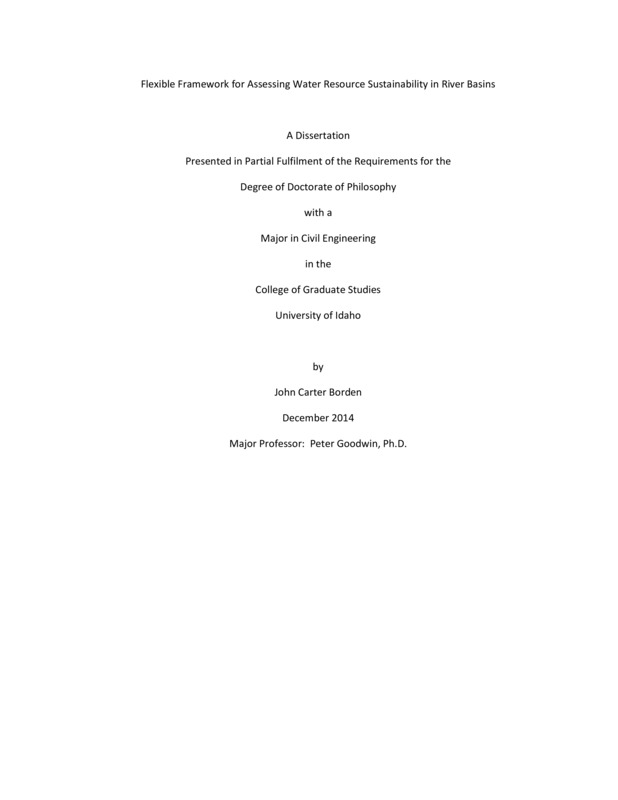Flexible Framework for Assessing Water Resource Sustainability in River Basins
Borden, John Carter. (2014). Flexible Framework for Assessing Water Resource Sustainability in River Basins. Theses and Dissertations Collection, University of Idaho Library Digital Collections. https://www.lib.uidaho.edu/digital/etd/items/borden_idaho_0089d_10019.html
- Title:
- Flexible Framework for Assessing Water Resource Sustainability in River Basins
- Author:
- Borden, John Carter
- Date:
- 2014
- Keywords:
- Ecosystems Services Hydrology Indicators River Basin Management Sustainability
- Program:
- Civil Engineering
- Subject Category:
- Hydrologic sciences; Civil engineering
- Abstract:
-
As the anthropogenic footprint increases on Earth, the wise use, maintenance, and protection of freshwater resources is key in the sustainability of development. Borne from efforts to promote sustainable development of water resources, integrated water resource management (IWRM) was advanced. Methodologies supporting IWRM implementation have largely focused on the overall process, but have paid limited attention to evaluation methods of ecologic, economic, and social conditions. To assist in assessing water resource sustainability, the River Basin Analysis Framework (RBAF) has been developed. The RBAF merges the UN GEO4 DPSIR approach, UN Millennium Ecosystem Assessment approach, and principles of sustainable development to enable users to better understand spatiotemporal interactions between hydrologic, socio-economic, and ecologic systems and evaluate impacts of disturbances on ecological goods and services and human well-being (HWB). The RBAF provides new methods and tools to identify and employ analytical processes for conducting assessments of sustainability and policy alternatives.
The RBAF is comprised of a Conceptual Template (RBAF-CT), for assessing the situation and guiding indicator selection, and an Analytical Interface (RBAF-AI) for organizing and processing analytical results. The RBAF-CT connects constituents of HWB directly, or through EGS, to the relevant hydrologic cycle components. Associated with these constituents/components are relevant pressure, state, and impact indicators for use in assessing conditions and analyzing ecological, economic, and social conditions. Disturbance Templates for eight pressure types (e.g. population growth) guide users on the potential changes to the hydrological cycle and associated systems. The RBAF-AI organizes the output data from hydrologic, ecologic, economic, and social analyses and, with respect to time and space, computes the reliability, resilience, and vulnerability of the impact indicators for various water use scenarios. Results are presented in a timeline of sustainability indicators in ecologic, economic, and social conditions and a star plot for the overall conditions for easy comparison. The RBAF was applied to the Lemhi River Basin, Idaho, and the Upper Bhima River Basin, India (RBAF-CT only). The RBAF supports the IWRM process by providing a structured means to frame and analyze water related issues and select appropriate indicators to assess the sustainability of water programs and policies in river basins.
- Description:
- doctoral, Ph.D., Civil Engineering -- University of Idaho - College of Graduate Studies, 2014
- Major Professor:
- Goodwin, Peter
- Committee:
- Daley-Laursen, Steven; Michelsen, Ari; Swanson, Darren; Tuthill, David
- Defense Date:
- 2014
- Identifier:
- Borden_idaho_0089D_10019
- Type:
- Text
- Format Original:
- Format:
- application/pdf
- Rights:
- In Copyright - Educational Use Permitted. For more information, please contact University of Idaho Library Special Collections and Archives Department at libspec@uidaho.edu.
- Standardized Rights:
- http://rightsstatements.org/vocab/InC-EDU/1.0/

